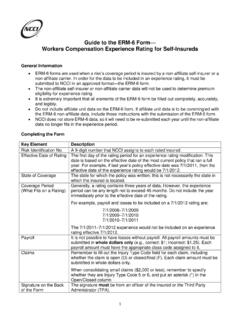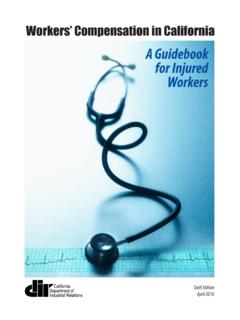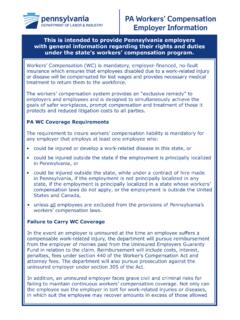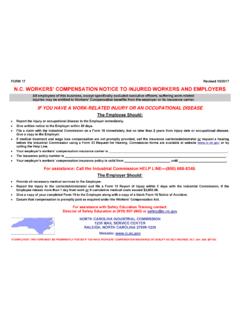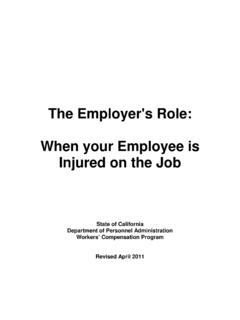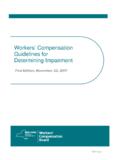Transcription of Latest Trends in Worker Demographics - NCCI Holdings Inc.
1 March 2021. By Patrick Coate Latest Trends in Worker Demographics KEY FINDINGS. The US labor force age 65 and older is expected to grow by more than 50% in the next 10 years, making it 10% of the total labor force Injury frequency has increased for four consecutive years for workers age 65 and older, even as injury frequency's long- run decline has continued overall, especially for workers age 25-44. Older workers tend to have more days away from work given an injury, both within and across injury types Women's employment is growing faster than men's employment at younger ages, but men's employment is growing faster than women's at older ages Employment rose more for college graduates than other education groups before the pandemic and has fallen less for college graduates since the beginning of the pandemic Women and the workers under age 25 experienced larger employment declines at the height of the pandemic than other demographic groups There may be long-run demographic changes in employment caused by the pandemic, especially for women, even though employment differentials for demographic groups partially converged after the initial impact in April 2020.
2 INTRODUCTION. Because work injury experience differs between different types of workers, demographic changes are important to workers compensation. This paper highlights current and projected demographic patterns in employment, as well as data on injury frequency and time away from work. This paper has a dual focus. First, we show long-term Trends in the distribution of age, gender, education, and tenure of the US workforce and discuss their relevance to workers compensation. The long-term Trends continue to show patterns we have commented on in prior work with some small but important differences in the most recent data before the coronavirus (COVID-19) pandemic's major impacts on employment, meaning through February 2020. 1. Second, we show evidence of the impact of the pandemic on workplace Demographics in 2020. COVID-19 had a seismic effect on the US labor market, with more job losses between February and April of 2020 than in all of 2008 and 2009 during the Great Recession.
3 The demographic impact of the pandemic and associated recession has been like prior recessions in some ways and unlike it in others. 1. This analysis generally follows the structure of NCCI's AIS 2020 presentation Latest Trends in Worker Demographics ; however, the data is updated. Copyright 2021 National Council on Compensation Insurance, Inc. All Rights Reserved. THE RESEARCH ARTICLES AND CONTENT DISTRIBUTED BY NCCI ARE PROVIDED FOR GENERAL INFORMATIONAL PURPOSES ONLY AND ARE PROVIDED. AS IS. NCCI DOES NOT GUARANTEE THEIR ACCURACY OR COMPLETENESS NOR DOES NCCI ASSUME ANY LIABILITY THAT MAY RESULT IN YOUR. RELIANCE UPON SUCH INFORMATION. NCCI EXPRESSLY DISCLAIMS ANY AND ALL WARRANTIES OF ANY KIND INCLUDING ALL EXPRESS, STATUTORY AND. IMPLIED WARRANTIES INCLUDING THE IMPLIED WARRANTIES OF MERCHANTABILITY AND FITNESS FOR A PARTICULAR PURPOSE. 1. We discuss some of the pandemic's effects on the labor force by age, gender, and education the main demographic categories that this paper focuses on.
4 The effects by age and education are directionally similar to those in prior recessions, but the pandemic-related recession has had a disproportionate impact on women. AGING WORKFORCE. In the past 10 years, the US labor force has grown older. Exhibit 1 shows that between 2009 and 2019, the labor force grew at every age group except under 25. Workers 65 and older increased from million to million, a 63% increase. The labor force from age 25 to 44 and age 45 to 64 grew as well, but each declined as a share of the labor force due to the rapid increase of workers 65 and older. Americans under 25 declined both as a share of the workforce and in absolute terms. Per the US Bureau of Labor Statistics (BLS) Employment Projections program, the next 10 years are expected to follow similar patterns, but the workforce may change even more dramatically. By 2029, million people 65 and older are projected to be in the labor force, a 55% increase from 2019 and nearly 10% of the projected workforce overall.
5 The under- 25 workforce is projected to continue to decline. Interestingly, the labor force age 45 64 is projected to decline between 2019 and 2029. Besides age 65 and older, the age 25 44 range is the only age group projected to increase, with similar growth as in the last 10 years. The explosion into the workforce of older Americans near or past traditional retirement age is the product of two main factors: The continued aging of baby boomers Increasing labor force participation of Americans age 65 and older Baby boomers are defined as those born between 1946 and 1964, meaning they started to reach age 65 in 2011 and will all have reached that age by 2029. The biggest reason more Americans age 65 and older are in the labor force is simply that there are many more such Americans. A secondary reason is that older Americans are staying attached to the labor force in larger numbers. For those age 65 and older, the labor force participation rate rose from 17% in 2009 to 20% in 2019 and is expected to rise again to 23% by 2029.
6 The labor force participation rate has been relatively steady for working-age Americans, age 25 64, and is expected to remain so. Because of their increasing numbers and propensity to work, older Americans will be an increasingly important demographic for work and workers compensation. In 10 years, 1 Worker in 10 will be age 65 or older, and 1 in 4 people age 65 and older will work. 2. Pandemic Employment Effects by Age Younger workers and those with less education tend to be the first to be laid off in a recession or be less likely to be hired at all. We saw evidence of this in 2020. The largest employment declines at the onset of the recession were for the youngest and least-educated workers. 2. Exhibit 2 shows the percentage change in employment by age from a February 2020 baseline, as measured by the Current Population Survey. The most striking element of the chart is the 30% decline in employment for workers age 16 24. This reflects layoffs in all industries of young, less experienced workers, especially restaurant and retail jobs that employ many young people and that the pandemic strongly affected.
7 Other differences are smaller. The middle categories, age 35 44 and 45 54, suffered 11% 13% declines in employment compared to 15% 16% for age 25 34 and age 55 and older. 3. However, by the end of 2020 all age groups had partially recovered to a 4% 7% decline from the February baseline. While the youngest workers suffered most through the summer of 2020, followed by workers age 25 34 and 55 and older, it does not appear that COVID-19 has significantly changed the age composition of US employment. Injury Frequency and Severity by Age demographic shifts matter to workers compensation when they are likely to change injury experience, and we know that younger and older workers tend to have different injury rates, suffer different types of injuries, and have different recovery periods. In prior decades, the pattern of work injuries by age was clear: younger workers had higher injury rates, but older workers had more severe injuries. Exhibit 3 shows that in the last 15 years, the first part of this pattern ceased to be true.
8 Work injury frequency declined at all ages, but in our 2019 paper on Changing Workforce Demographics , 4 we showed that there was a substantially sharper decline among workers age 25 44 than other age groups. In fact, per BLS data from the Survey 2. Kim Parker et al., Economic Fallout From COVID-19 Continues to Hit Lower-Income Americans the Hardest, Pew Research Center, September 24, 2020. 3. We use 55 and older in this section rather than 65 and older because of data availability. 4. Changing Workforce Demographics and Injury Frequency, , April 1, 2019. 3. of Occupational Injuries and Illnesses, 5 since 2017 such workers have had the lowest injury rates of any of our four main age groups. While injury frequency declined at most age ranges, work injury frequency for those age 65 and older increased. Frequency for workers age 65 and older increased every year since 2015 and cumulatively by 14% from 2015 to 2019. In this time period, while other age groups experienced occasional year-over-year increases in frequency, no other age group has had a consistent upward trend in BLS data.
9 We cannot write off the increase in older workers' injury frequency. Median Days Away From Work Workers have significantly different injury patterns for severity as well as frequency by age. Older workers tend to have longer times away from work given a type of injury. In BLS data, the primary measure of severity is median days away from work. 6. 5. The Survey of Occupational Injuries and Illnesses data in this paper is through 2019, released November 2020. This updates exhibits from the AIS 2020 presentation, which used data through 2018. 6. The median is calculated for the subset of injuries that require at least one day away from work. 4. As shown in Exhibit 4, older workers have much higher median days away from work than do younger workers. 7 Given that we know Worker mix varies by age, as shown in the previous section, a natural question is how much of the difference by age can be explained by the kinds of injuries suffered? Injury type is a partial explanation for the discrepancy in days away from work, although not the main factor.
10 As shown in Exhibit 5, falls, slips, and trips make up a higher proportion of older workers' injuries than younger workers' injuries, whereas the opposite is true for contact with objects or equipment injuries. Overexertion injuries constitute a lower proportion of injuries for both the youngest and oldest workers than for those 25 64. Contact injuries tend to have the fewest days away from work of the three major BLS injury classifications, so injury mix does tend to put upward pressure on days away from work for older workers. However, the main reason for the discrepancy in days away from work by age is that older workers tend to have longer recovery periods within each injury type. Exhibit 6 shows the days away from work for each major injury type by age range. 7. In certain years, such as the 2018 data presented at AIS 2020, the median days away from work for ages 55 64 is higher than age 65 and older, but the general pattern of increasing days away from work by age holds in all years.

